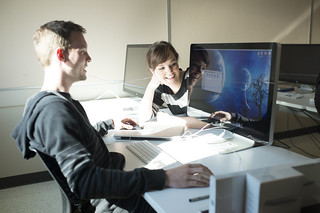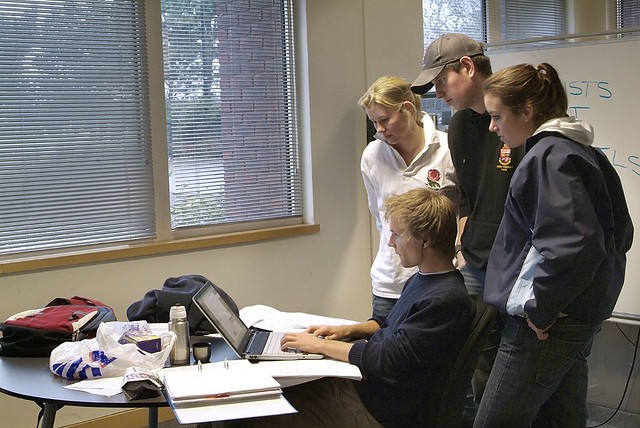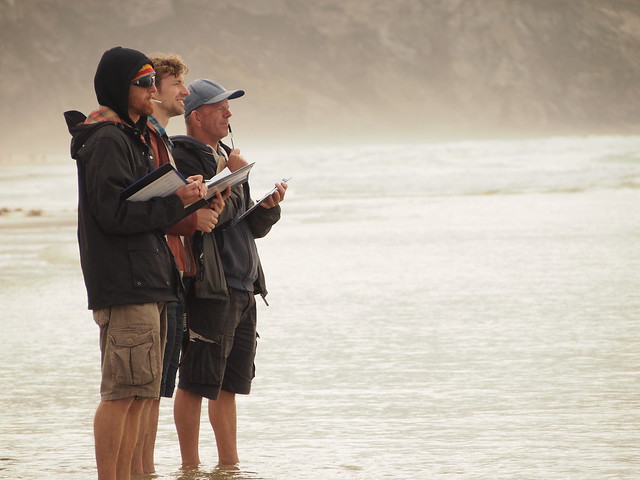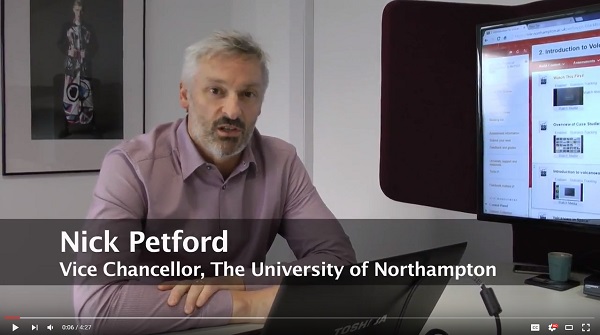Over the past couple of years, lots of different people have asked me about our curriculum change project here at UoN. From teaching staff and students here at the University, to Northampton locals and parents, and even learning and teaching experts at other universities, there is increasing curiosity around the idea of a university without lectures. The lecture theatre has long been an iconic symbol of higher education, heavily featured in popular culture as well as many university recruitment campaigns. So how to explain why we think that we can do better?
Here are some of the reasons why I think that active blended learning (or “you know, just teaching” as I often hear it described), is the way of the future* for student success. What are yours?
- It’s effective for learning. Pedagogic research tells us that it is important for students to be actively involved in their learning – that is, to have opportunities to find, contextualise and test information, and link it to (or explore how it differs from) their prior understanding. Students who construct their own knowledge develop a deeper understanding than students who are just given lots of information, memorise it for the assessment and then promptly forget it. Who was it that said “Tell me and I forget, teach me and I may remember, involve me and I learn”? There is debate about the source of the quote, but there’s a reason it has endured…
- It can be more inclusive. Writers and educators like Annie Murphy Paul and Cathy Davidson are among many who question whether lecturing as a teaching approach benefits some students more than others – or indeed whether the students who succeed most in lecture-intensive programmes are doing so in spite of (rather than because of) the teaching approach. Now, active blended learning is not an easy fix for this challenge, and if not carefully designed it can also create environments that can disadvantage some learners (noisy classrooms can be difficult for students with language or specific learning difficulties, for example, and online environments can be challenging in terms of digital literacy). But with forethought and planning, ABL can help to ensure that all students have a voice and a role in the learning environment, and evidence suggests that it can reduce the attainment gap for less prepared students.
-
It’s more engaging / interesting / fun! When Eric Mazur used Picard et al.‘s electrodermal study to point out that student brainwaves (which were active during labs and homework) ‘flatlined’ in lectures, he may have been at the extreme end of the argument. But from the student perspective, anyone who has been a student in a long lecture (or who has observed rows of students absorbed in their laptops or phones) knows how easy it is to switch off in a large lecture environment. And from the tutor perspective, anyone who has been tasked with giving the same lecture multiple times knows that interaction and contribution from the students is vital to breaking it up. Smaller, more discursive classrooms allow for variety; for more and different voices and ideas to be shared.
- It scaffolds independence. Our students are only with us for a short time. If we teach them to depend on an expert to tell them the answers, what will they do when they don’t have access to those experts any more? The Framework for Higher Education Qualifications says that graduates should, among other things, be able to “solve problems”, to “manage their own learning”, and to make decisions “in complex and unpredictable contexts”. Our graduate attributes say that our students should be able to communicate, collaborate, network and lead. We don’t learn to do these things just by listening to someone else tell us how.
- It recognises how learning works in the real world. Think about the last time you really tried to learn something new. How did you go about it? You may have been lucky enough to have access to experts in that area, but chances are – even if that’s true – you also looked it up, asked some people, maybe tried a few things out. Probably you synthesised or ‘blended’ information from more than one source before you felt like you’d really ‘got it’. To be a lifelong learner, we need to be able to find and assess information in lots of different ways. This is exactly what our ABL approach is trying to teach.
Our classrooms at Waterside may look different to the iconic imagery commonly used to depict the university experience. But maybe it’s about time…
*Looking back on the development of university teaching, there is some debate around how we got to where we are: around what is ‘traditional‘ and what is ‘innovative’ in teaching; and also on whether the ubiquity of the lecture is a result of the economics of massification rather than the translation of pedagogic research into practice. Although it is always good to keep an eye on how practice has developed, I see no need to replicate these debates here – instead, this post is deliberately intended to be future focused, on how best to move forward from this point.
This video from Dr Rachel Maunder, Associate Professor in Psychology, provides some examples of active, blended learning approaches that Rachel has tried in her modules so far. Rachel shares two different models, one which focuses on linking classroom activity to independent study tasks online, and one which includes some teaching in the online environment in addition to face to face sessions. Rachel also shares useful lessons she has learned from her experiences so far.
If you have questions about either of these approaches, Rachel is happy to take these via email.
This post is one in a series of ABL Practitioner Stories, published in the countdown to Waterside. If you’d like us to feature your work, get in touch: LD@northampton.ac.uk
As a result of the University’s Active Blended Learning strategy, some teaching staff are considering using some contact time to support learners in the online environment as well as in the classroom. There are many reasons why you might choose to do this: perhaps you want to increase the flexibility for your cohort so they don’t have to travel; perhaps you need to help your students develop their digital literacy; perhaps running a teaching session online allows you to do something you couldn’t do in the classroom (like including a guest speaker, or allowing students time to draft and revise before sharing their thoughts). Or perhaps you just want to add some more structure, guidance and feedback to regular independent study activities.
Whatever your motivation, there are some tips that can help you think about how to use that contact time well, and make online learning a rewarding experience for you and your students.
Transparent pedagogy and clear expectations
Recent research with our students highlighted that they don’t always feel prepared for independent study, and often come to university expecting to ‘be taught’ rather than to have to work things out for themselves (the full report can be downloaded here). Scaffolding the development of independent learning skills is a gradual process, with implications for online as well as classroom teaching – particularly as this way of learning may be new to your students too (at least in formal education contexts). So how do you avoid students feeling like they’ve been ‘palmed off’ with online activities, when national level research tells us that many applicants expect to get more class time than they had at school?
 It’s worth setting time aside early on to have frank conversations about how learning works at university level, and about how the module will work, but also about why those choices have been made. Students can sometimes be unaware of the level of planning and design work that goes into a module, so it helps to explain why you’re asking them to do the tasks you’ve planned – in the discussion forum, for example, why is it important for them to engage with opinions or ideas shared by other students? You don’t need to be an expert on social constructivism to explain that learning to research, communicate and collaborate online are crucial skills for graduates. And if it’s the first time you’ve tried something, don’t be afraid to say so, and acknowledge that you’re learning together! Keeping the conversation open for feedback on teaching approaches will help improve them in the future.
It’s worth setting time aside early on to have frank conversations about how learning works at university level, and about how the module will work, but also about why those choices have been made. Students can sometimes be unaware of the level of planning and design work that goes into a module, so it helps to explain why you’re asking them to do the tasks you’ve planned – in the discussion forum, for example, why is it important for them to engage with opinions or ideas shared by other students? You don’t need to be an expert on social constructivism to explain that learning to research, communicate and collaborate online are crucial skills for graduates. And if it’s the first time you’ve tried something, don’t be afraid to say so, and acknowledge that you’re learning together! Keeping the conversation open for feedback on teaching approaches will help improve them in the future.
In conversations about pedagogy, be sure to make space for your students to talk about their expectations and previous experiences. This might help them identify aspirations and areas for development, but it will also inform your planning, and a shared understanding of responsibilities will make the learning process run much more smoothly. Consider co-creating a ‘learning contract’, exploring issues like how often you expect them to check in on social learning activities on NILE, and how (and how quickly) they can expect to get responses to questions they pose there.
Building relationships
A key element of success in any learning environment is trust. This doesn’t just mean students trusting in you as the subject expert, and trusting that the work you’re asking them to do is purposeful and worthwhile (see above). It also means trusting that your classroom (whether physical or online) is a safe space to ask questions, and that feedback from peers as well as from you will be constructive and respectful. Some of this can be explicitly addressed with a shared ‘learning contract’, as above, but it also helps to reinforce this through the learning activities themselves. In the online environment, introducing low-risk ‘socialisation’ activities early on can help to build confidence and a sense of community, which will be invaluable in the co-construction of knowledge later on (see Salmon’s five stage model for more on this). Simple things like adding the first post to kick off a conversation, and explicitly acknowledging anxieties about digital skills, can make all the difference.
 Trust also means students trusting that their contributions in the learning space will be acknowledged and valued. Many online tools, such as blogs and discussion forums, are specifically designed with student contribution as the focus, but with live tools, like Collaborate, you may need to plan activities specifically to support this, so that it’s not just you talking. After all, you wouldn’t expect a discussion forum to be composed of one long post from you, so with live sessions, the same principles apply! (see Matt Bower’s Blended Synchronous Learning Handbook for ideas).
Trust also means students trusting that their contributions in the learning space will be acknowledged and valued. Many online tools, such as blogs and discussion forums, are specifically designed with student contribution as the focus, but with live tools, like Collaborate, you may need to plan activities specifically to support this, so that it’s not just you talking. After all, you wouldn’t expect a discussion forum to be composed of one long post from you, so with live sessions, the same principles apply! (see Matt Bower’s Blended Synchronous Learning Handbook for ideas).
On the flip side of this, you also wouldn’t expect a student who was speaking in a live webinar to keep trying if they didn’t get a reply. So using the same principles, if you’re planning asynchronous (not live) learning activities, make sure you schedule teaching time to review your students’ views and ideas, whether online or in the next face to face session. Online, techniques like weaving (drawing connections, asking questions and extending points) and summarising (acknowledging, emphasising and refocusing) are invaluable, both for supporting conversation and for emphasising that you are present in the online space (see Salmon 2011 for more on these skills).
And if some of your students haven’t contributed, don’t panic! There could be lots of reasons for this. It may be a bad week for them, or a topic they don’t feel confident in, in which case chances are they will still learn a lot from reading the discussion. It may be that someone else already made their point – after all, if you were having a discussion in the classroom, you wouldn’t expect every student to raise a hand and tell you the same thing (if you need to check the understanding of every single student, maybe you need a test or a poll instead of a discussion). If participation is very low though, it may be that you need to reframe the question (as a starter on this, this guide from the University of Oregon, although a little outdated in technical instructions, includes some useful points about discussion questions for convergent, divergent and evaluative thinking).
Clarity, guidance, instructions, modelling
Last but by no means least, with online learning it helps to remember that students need to learn the method as well as the matter. A well-organised NILE site, clear instructions and links to further help will go a long way, but nothing beats modelling. Setting aside time in your face to face sessions to walk through online activities and address questions will save you lots of time in the long run.
I want to change my programme structure…
I want to include a placement / work-based learning / a Changemaker challenge…
I want to use a particular assessment or technology…
I want to ensure an equivalent experience for students at other sites…
What do I need to do?
The Learning Design team have collated a document listing the most frequently asked questions from CAIeROs and consultations over the past two years, along with answers provided by the appropriate support teams. Hopefully the guidance here can help you identify the processes and teams that are in place to support you with a range of course design issues including quality assurance, assessment, distance learning and technology issues.
The list has been added to the Sharing Higher Education Design (S.H.E.D.) site on NILE. You can access the site at http://bit.ly/SHED-NILE, but you will need to be enrolled to view the document.
We’ll keep this document updated as new questions and answers come up. Want to submit a question that we haven’t covered? Just email it to the Learning Design team at LD@northampton.ac.uk.
What is “blended learning”?
 “Blended learning” is an umbrella term, referring to learning activity that happens across contexts. The ‘blend’ is usually between learning activity happening inside and outside the classroom, or between learning that happens in real-world and online environments (or both!). Many of us learn in this way every day, informally – we might look up information in books and online, discuss it with peers over coffee and via email, draft new ideas on paper and on the laptop. As technology becomes ubiquitous, we need to be able to take advantage of both physical and virtual learning opportunities, to recognise the strengths and weaknesses of each, and to synthesise learning from different contexts. The challenge for educators is to design the right ‘blend’ of activity – both to support specific learning, and to help students to develop their independent learning skills for the future.
“Blended learning” is an umbrella term, referring to learning activity that happens across contexts. The ‘blend’ is usually between learning activity happening inside and outside the classroom, or between learning that happens in real-world and online environments (or both!). Many of us learn in this way every day, informally – we might look up information in books and online, discuss it with peers over coffee and via email, draft new ideas on paper and on the laptop. As technology becomes ubiquitous, we need to be able to take advantage of both physical and virtual learning opportunities, to recognise the strengths and weaknesses of each, and to synthesise learning from different contexts. The challenge for educators is to design the right ‘blend’ of activity – both to support specific learning, and to help students to develop their independent learning skills for the future.
There are two key principles to remember if you’re new to blended learning. The first is to start with the right task for the learning, and then find the right tool (don’t choose a tool and then try to find a use for it!).
The second principle is the ‘blending’ part. The idea of this is that one type of learning activity supports and feeds into the other, and connections and transferability are clear.
Getting started with blended learning
You can ‘blend’ almost any kind of teaching, by starting to add in activities that help students bridge the learning they are doing inside and outside taught sessions. There is no ‘one size fits all’ approach, because each learning activity will depend on what you want to achieve. Starting small, with one type of activity or tool, can help you and your students build confidence and skills, and figure out what works well and what doesn’t. Here are some tips for designing learning activities online:
- Identify learning that can be done outside class time. Sometimes the best way to do this is to think about what you would really like to be able to do with your students in the classroom, and work backwards. Storyboarding can help with this.
- Design the right activity to support the learning. What should the student be doing in order to learn this? Who else should be involved? What resources will they need? Prompts like the Hybrid Learning Model cards can help you to frame different kinds of learning activities.
- Once you have a clear idea of what you want to happen, then choose the right tool to support this type of activity. The University provides a core set of tools that we have vetted for you. Beyond this there are hundreds of possibilities! All of these have strengths and weaknesses, but don’t worry, you don’t need to be a tech guru. The Learning Technology team can help with this.
 Many people begin by transferring a learning activity that they already know works well into the online environment. For example, if you would usually ask your students to discuss a contentious idea, or defend a position in a debate, you could do this in an online forum, or if you would usually demonstrate something for the students, you could do this using video. If you’re a little more confident, you might want to think of some ways that technology can extend your teaching and allow you to do things that you couldn’t do in a traditional face to face setting. You might use it to connect students to resources, peers or external experts. You might use it to provide visualisations of text-based materials, or to build knowledge checks that provide students with instant feedback, or to create spaces where they can pool their own resources and ideas to inform their work.
Many people begin by transferring a learning activity that they already know works well into the online environment. For example, if you would usually ask your students to discuss a contentious idea, or defend a position in a debate, you could do this in an online forum, or if you would usually demonstrate something for the students, you could do this using video. If you’re a little more confident, you might want to think of some ways that technology can extend your teaching and allow you to do things that you couldn’t do in a traditional face to face setting. You might use it to connect students to resources, peers or external experts. You might use it to provide visualisations of text-based materials, or to build knowledge checks that provide students with instant feedback, or to create spaces where they can pool their own resources and ideas to inform their work.
Tips for success
Be clear about the why and the how. Sometimes staff who try blended learning for the first time find that students don’t engage as they had hoped with the online activity. Student feedback tells us this is usually because either they don’t understand it, or they don’t see the value. When introducing online tasks, it helps to make it clear why they are being used, and how they will help students to achieve the learning outcomes. It’s also a good idea to explain any unfamiliar tools or processes in advance, just as you would when introducing a new task in the classroom. If you can, get a student perspective on your design before you launch it – and maybe try some online courses yourself, to see what it’s like on the other side!
Be realistic. Be aware that creating online resources and supporting online activity might require slightly different skills to the ones you use in the classroom, so allow yourself time to develop these. Think too about the ratio of effort to impact for your module – creating complex professional-looking resources requires a big investment of time in advance, although this may be worth it if there is one sticky concept that students really struggle with early in their studies. On the other hand, you may be able to get the same effect by using existing resources on that topic and asking students to critique them, or even by asking students to research the topic and share their own key resources. You don’t need to be a computer genius (or spend months learning complex software) to create that lightbulb moment!
Learn from others. Working in a team can really help here – not just in terms of sharing the workload and learning new skills, but also in setting consistent expectations for students across different modules on the same programme. If you’re stuck for ideas, have a look of some of our case studies, or ask around to see what colleagues are trying.
Do one thing
Ready to give it a try? If you want help figuring out what to blend, at a session, module or even programme level, the Learning Design team can help. If you already have an idea for an online activity, but you’re not sure about the technology, the Learning Technology team can help. Get in touch and we’ll help you get started!
What are the factors that encourage and inhibit student engagement in online activities, such as e-tivities? This was the question that URBAN project run by Elizabeth Palmer, Sylvie Lomer, Laura Wood and Iveline Bashliyska sought to answer. This blog post outlines some of their findings.
Much research has been done into what makes a ‘good’ e-tivity (Swan, 2001; Sims et al., 2002; Lim et al., 2007; Salmon, 2013; Clark & Mayer, 2011; University of Leicester, n.d.):
- clear instructions and design,
- purposeful,
- perceived relevance,
- practice opportunities,
- interactive,
- structured pathways and sequencing,
- effective feedback
- interactions with the tutor
An amalgamation of tips gleaned from this research, such as Gilly Salmon’s “E-tivities: The Key to Active Online Learning” (available from the University library), and the experience of various University of Northampton staff who have been trialling e-tivities over the past year or so is available here: Tips for etivities and blended learning (PDF) It is not by any means definitive but might be helpful!
The Learning Development team (formally known as the Centre for Achievement and Performance: CfAP) offer a range of transferable cognitive and academic skills development opportunities for students, through both face-to-face and online delivery. Workshops delivered are embedded in subject courses and modules, on request from lecturers and module leaders. In the last year Learning Development has been modifying its delivery of workshops from a solely face-to-face model to a blended model of delivery in accordance with the University’s new pedagogical model. (See the Learning & Teaching Plan and information about Waterside for more detail). The aim of this approach was to provide online activities that would offer scalable opportunities for personalised, independent online learning that provide low pressure opportunities for students to practice academic skills and to maximize the impact of face to face time with students.
A variety of different approaches have been taken to this new blended delivery including; opportunities for structured writing practice; opportunities to shape the content of face-to- face workshops; discussion boards based around students’ concerns with academic and cognitive skills; preparatory writing exercises; interactive activities developing and modelling specific skills such as synthesis and formative individual feedback on written tasks. However, even when following good e-tivity design principles, student engagement with Learning Development designed e-tivities has varied markedly. For this reason a research project in LLS was undertaken to uncover more detail from students about their engagement with e-tivities. The project adopted qualitative methodologies involving students as co-researchers in order to uncover the causes and factors underpinning this variation, focus groups were conducted with staff and students involved in some of the blended learning activities at UoN.
The first finding was that students did not differentiate between CfAP activities and those of their module tutor. As a consequence it is possible to generalise the results as applicable to blended learning activities regardless of the tutor responsible for setting the activities.
The results can be seen to belong to one of two categories: ‘conditions’ for blended learning and ‘factors’ for student engagement. ‘Conditions’ are necessary and universal for all students; if the conditions cannot be met, successful engagement with blended learning through online activities is highly unlikely. Responsibility for conditions lies with staff and institutional policies and engagement. In contrast, the factors affecting student engagement are individual, personal and particular to the student, cohort and discipline. They do not lie entirely within the control of staff; that said they can be supported and bettered through effective educational practices. For example, a student may have low resilience for challenging activities and although staff can support the student in developing better resilience they cannot create resilience for the student; this constitutes a factor. Conversely, staff can establish accessible e-tivities and effectively communicate their purpose and how to complete them; this constitutes a condition.
The conditions and factors are as follows:
Fundamental conditions for Blended Learning:
- Staff engagement and student-staff relationship: This condition highlights the significance of staff motivations, beliefs and approaches to blended learning and relationships with student. Students nearly always mirror the staff’s views.
- Communication: This condition pertains to the requirement that communication between staff and students, around the purpose, pedagogical rationale and instructions for tasks, be fully transparent.
- Well designed VLE and online learning: This condition pertains to issues of design, navigation, layout etc.
Factors impacting engagement with blended learning:
- Student digital literacy and technology preferences: This factor indicates the extent to which individual student engagement with technology impacts variance in student engagement.
- Student beliefs and motivations about and for learning: This factor indicates the way that inherited beliefs about learning in general, and specifically in relation to each individual students patterns of learning, impacts their engagement with blended learning
- Student capacity for self-management: This factor pertains to variance in individuals ability to self-manage their learning and the impact this has on engagement with blended learning.
Initial findings were disseminated at this year’s LLS conference at the University of Northampton and the research team are now in the process of writing these results up for publication in the coming months. For the LLS conference presentation please visit:
For further information on these, please contact Elizabeth Palmer and Sylvie Lomer.
See also Julie Usher’s post on Getting Started with Blended Learning:
Recent article from TeachOnline.CA entitled “A New Pedagogy is Emerging… and Online Learning is a Key Contributing Factor” does a really fantastic job of outlining current trends in pedagogy and the role that online learning is playing within this new pedagogy. If you haven’t seen it, I recommend having a look!
In summary, the article outlines 7 key elements of current pedagogical thinking as follows:
“1. Blended learning
2. Collaborative approaches to the construction of knowledge/ building communities of practice.
3. Use of multimedia and open educational resources
4. Increased learner control, choice and independence
5. Anywhere, anytime, any size learning
6. New forms of assessment
7. Self-directed, non-formal online learning. “
All these aspects can be seen to underpin the Teaching & Learning plan we are moving towards at the University of Northampton. Blended or Hybrid learning is seen as the new normal where online and technology enhanced learning blend seamlessly with face-to-face workshop time. Significant emphasis is placed on group based learning and social interaction as well as the learner being at the centre of designing, implementing and reflecting on learning experiences.
Most university lecturers will have their favourite anti-lecturing quote. Mine has always been Camus’ oft-quoted “Some people talk in their sleep. Lecturers talk while other people sleep”. Another favourite is the variously attributed definition “Lecture: a process by which the notes of the professor become the notes of the student, without passing through the minds of either.”
In fairness to university lecturers, none of the lecturers I know deliver these kind of dreary monologues. Also, if a lecturer is timetabled into a room with a lectern, projector and screen, and tiered seating containing 250 students then surely we cannot chastise them for using that room for the purpose it was designed and intended for. Obviously such space can be subverted and used differently (as professors such as Eric Mazur and Simon Lancaster have done), but surely the best solution is simply not to build these kinds of spaces in the first place. If active, participatory learning in small groups is what is best (and the evidence suggests that it is) then why not build spaces that accommodate this kind of learning and teaching.
At the University of Northampton that’s exactly what is happening. As was recently reported in the Sunday Times, the University of Northampton’s Waterside campus “is to be built with no traditional lecture theatres, providing further evidence that the days of professors imparting knowledge to hundreds of students at once may be numbered.” The new campus “is the first in the UK to be designed without large auditoriums.”
While it is true that the majority of teaching that takes place at the Waterside campus is planned to be active, interactive and participatory, and to take place in small classes, there will obviously need to be some element of professors imparting knowledge to their students. This is, after all, for most people a key part of the process of teaching and learning. However, the plan for Waterside is for such ‘professorial knowledge imparting’ to take place online, prior to attending class; a process often known as flipped or blended learning. This means that time is not taken up in the small class sessions with getting knowledge across to the students, or with ‘covering content’, but on helping students to understand, assimilate and make sense of the knowledge they have grappled with prior to attending class.
Professor Nick Petford, Vice Chancellor of the University of Northampton, is not only building a campus in which active, participatory, small class teaching will be the norm, but as a member of the teaching staff he is already teaching in this way himself. Professor Petford adopted this blended learning approach in his physical volcanology classes during the 2015/16 academic year, and you can see him talking about how it went in this video.
As in previous years, LearnTech have been working with colleagues in Curriculum and IT on the creation of new NILE course (programme) and module sites for the forthcoming academic year, only this year with a twist: instead of routinely copying over all teaching materials from earlier site iterations, we are taking this opportunity to review and ‘spring clean’ legacy content, particularly with a nod to the course evaluation and redesign coming out of recent CAiEROs.
The updated and fresh NILE template, proposed at (and tweaked on the back of consultations with) the SEC (Student Experience Committee) on 24th February and with the Learning and Teaching Forum, has resulted in the creation of 4,251 ‘clean’ sites, now ready and already receiving content.
Following the updated minimum NILE standards, LearnTech and Academic Librarians have so far worked with colleagues from the Schools of Education and Health running a total of 11 sessions covering changes to the template; reviewing and copying relevant content; checking curriculum data and reading lists and populating sites ready for the new student intake.
The Team is now working on the roll-out to the Business School and is in contact with subject leads from the Schools of Social Sciences, Arts and SciTech, identifying local support needs, creating online resources to help guide site population and working with colleagues from other University support teams to ensure everything is set up and in place for the new academic year – where possible, before the summer vacation strikes!
Stage 3 of the CAIeRO process usually begins at the start of the second day. By this stage you should have your blueprint and storyboard finalised, and a clear vision of your new module design(s). The next step is to start making your ideas more concrete, by creating the learning and teaching activities that will support students to reach the learning outcomes.
 On your storyboard, you will have a number of placeholders along the learning journey where students need to learn particular things. Pick one of these to start with, and think about what kind of learning activities might help the students to get to grips with it. Is it a new concept or skill, where they will need some initial information or a demonstration from you (or someone else) to get started? Is it a complex idea or skill they will need some time to explore? Is there an opportunity to let them apply it, through experimentation or practice? Is it an area where they might benefit from sharing knowledge or experience, or being exposed to different perspectives through debate? You might find the Hybrid Learning Model cards helpful here, as they list verbs describing what the tutor and the student can do to support different types of learning.
On your storyboard, you will have a number of placeholders along the learning journey where students need to learn particular things. Pick one of these to start with, and think about what kind of learning activities might help the students to get to grips with it. Is it a new concept or skill, where they will need some initial information or a demonstration from you (or someone else) to get started? Is it a complex idea or skill they will need some time to explore? Is there an opportunity to let them apply it, through experimentation or practice? Is it an area where they might benefit from sharing knowledge or experience, or being exposed to different perspectives through debate? You might find the Hybrid Learning Model cards helpful here, as they list verbs describing what the tutor and the student can do to support different types of learning.
Creating learning activities
This section of the workshop is sometimes thought of as the ‘e-tivity bit’, but it’s important not to think too much about the technology to start with. Think about the type of activity you think would work best. If you or your colleagues have taught that subject before, what worked well? Once you know what you’d like the students to be doing, then think about the context – is this something that needs to happen in the classroom or outside? Technology can add possibilities and allow us to design learning experiences that weren’t possible in the past – think about linking up live with an expert in the field, or providing your students with world-class open educational resources. It’s also important to make sure that your students are exposed to digital learning practices, and develop the skills they will need to keep learning beyond their degree. But online is not always the best mode for every activity, so if you have face to face time with your students, make sure you use it wisely!
To help you figure out the best context for each activity, it’s important to be aware of the strengths and weaknesses of the tools available to you. Your Learning Technologist can help you with this, and you may also be able to get advice from your colleagues on their experiences. Don’t be afraid to talk about things that haven’t worked well – it may be that there are new tools or skills that could help you tweak that activity so that it works better next time, and part of the aim of the CAIeRO is to develop your skills as well as your module!
This is why we will ask you to create at least one online learning activity in the learning environment (NILE) as part of the workshop. You can take advantage of all the skills in the room, and you’ll leave with something real that you can use in your teaching! If you wish, you can use the e-tivity template, which embeds some key principles for online learning activities, including having a clear purpose, active learning tasks and opportunities for reflection and feedback. Or if you prefer, you can design your own.The reality check
 Once you have some learning activities created in NILE, it’s time to take a break while your reality checkers look them over. Reality checkers will ideally be students, but can also be colleagues, externals, anyone who has not been involved in the design of the module so far. Remember too that they don’t have to be in the room, they just need to be able to access the learning environment! The purpose of this stage of the workshop is to get an objective view of what you have created, and to provide constructive feedback to help you improve it. It’s important that you resist the urge to ‘help’ or ‘explain’ things to your reality checkers – remember when your real students come to this activity, they may not be able to call you and ask for clarification! Ideally your activity should stand by itself, with clear instructions allowing anyone who hasn’t seen it before to understand the purpose and how to complete it.
Once you have some learning activities created in NILE, it’s time to take a break while your reality checkers look them over. Reality checkers will ideally be students, but can also be colleagues, externals, anyone who has not been involved in the design of the module so far. Remember too that they don’t have to be in the room, they just need to be able to access the learning environment! The purpose of this stage of the workshop is to get an objective view of what you have created, and to provide constructive feedback to help you improve it. It’s important that you resist the urge to ‘help’ or ‘explain’ things to your reality checkers – remember when your real students come to this activity, they may not be able to call you and ask for clarification! Ideally your activity should stand by itself, with clear instructions allowing anyone who hasn’t seen it before to understand the purpose and how to complete it.
Your reality checkers will complete a feedback form that you can refer back to afterwards. You may also want to ask them to run through their thoughts on the activities, to get some more detail (if they are not in the room you could do this using Collaborate or Skype).
Review and adjust
Once your reality checkers have left, it’s a good idea to take a short amount of time to do some adjustments based on their feedback, while it’s fresh in your mind. Then you’re almost done!
This is one in a series of posts about the CAIeRO process. To see the full list, go the original post: De-mystifying the CAIeRO.
Need a CAIeRO? Email the Learning Design team at LD@northampton.ac.uk.
Recent Posts
- Spotlight on Excellence: Bringing AI Conversations into Management Learning
- Blackboard Upgrade – December 2025
- Preparing for your Physiotherapy Apprenticeship Programme (PREP-PAP) by Fiona Barrett and Anna Smith
- Blackboard Upgrade – November 2025
- Fix Your Content Day 2025
- Blackboard Upgrade – October 2025
- Blackboard Upgrade – September 2025
- The potential student benefits of staying engaged with learning and teaching material
- LearnTech Symposium 2025
- Blackboard Upgrade – August 2025
Tags
ABL Practitioner Stories Academic Skills Accessibility Active Blended Learning (ABL) ADE AI Artificial Intelligence Assessment Design Assessment Tools Blackboard Blackboard Learn Blackboard Upgrade Blended Learning Blogs CAIeRO Collaborate Collaboration Distance Learning Feedback FHES Flipped Learning iNorthampton iPad Kaltura Learner Experience MALT Mobile Newsletter NILE NILE Ultra Outside the box Panopto Presentations Quality Reflection SHED Submitting and Grading Electronically (SaGE) Turnitin Ultra Ultra Upgrade Update Updates Video Waterside XerteArchives
Site Admin







